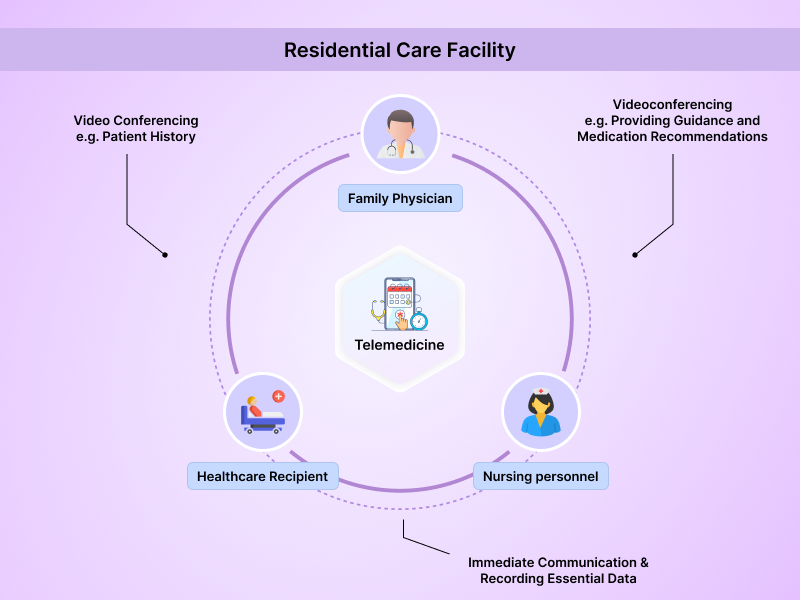
As per the 2023 World Social Report from the United Nations, the global population is experiencing a more rapid aging process than in any previous era. National News.com, a well-known platform for disseminating global news, reported that in 2021, approximately 761 million individuals were aged 65 and older. Projections suggest that this figure is anticipated to surge to 1.6 billion by the year 2050
It has been noted that contemporary individuals enjoy a significantly higher life expectancy, thanks to advancements in medical technology. As the number of elderly people and life expectancy continues to rise, there is a growing demand for geriatric care. Geriatric care encompasses services provided to seniors in residential care facilities and nursing homes, emphasizing the importance of ensuring a high quality of life and prioritizing their safety. However, the increasing demand for elderly care poses challenges.
To uphold the standard of medical care, harnessing emerging technologies to their fullest extent is crucial. Among the various options available, telemedicine solutions stand out as a top choice for enhancing elderly care in nursing homes. This blog delves into the detailed implementation of telemedicine solutions in nursing homes and explores the associated benefits.
What is Telemedicine in Healthcare?
Telemedicine in healthcare involves the practical application of healthcare services through telecommunication technologies, serving purposes such as diagnostic care and clinical intervention.
This encompasses remote doctor consultations facilitated by online communication channels like video conferencing and telehealth services. Users of telemedicine services have the advantage of accessing doctor consultations without being bound by location. This approach addresses inherent challenges in the healthcare sector, such as overcrowding in hospitals and clinics, and offers flexibility to both patients and medical professionals.
Telemedicine in Nursing Homes: Implementation & Benefits

In the dynamic healthcare landscape, the growing need for comprehensive elderly services presents challenges affecting residents, families, and caregiving staff. From lengthy waiting lists to adapting to new environments, these hurdles demand innovative solutions. Amidst these challenges, telemedicine in nursing homes emerges as a transformative approach, addressing logistical hurdles and enhancing the overall resident experience. Let’s delve into how telemedicine holistically tackles multifaceted issues faced by nursing home residents.
Provide Elevated Experiences to Care Home Residents
With the escalating demand for elderly healthcare services, individuals often encounter challenges such as enduring long waiting lists to secure placement in specific nursing homes. The difficulties persist even after residents secure a bed, as adjusting to a new environment, co-residents, and caregiving staff can be challenging. Many residents grapple with homesickness, missing their family members and the familiarity of their own homes. Additionally, adapting to a new set of regulations and care routines in the facility may prove troublesome for some seniors, potentially leading to anxiety and depression for both residents and their concerned loved ones.
Fortunately, the implementation of Telemedicine in nursing homes presents a solution to these challenges. Telemedicine solutions offer a means for seniors to acquaint themselves with the nursing home’s environment and staff through pre-entry videos. The videoconferencing capabilities further enable the elderly to maintain connections with their loved ones even after transitioning to the care home. This streamlined approach to the transition and adjustment process significantly reduces anxiety, providing a more seamless experience for residents and their families.
Reduce travel time to Appointments
One of the key benefits of implementing telemedicine in nursing homes is the significant reduction in the time required for residents to schedule and attend healthcare-related appointments. Nursing home residents typically have multiple weekly appointments, such as those with practitioners, dentists, therapists, physiotherapists, and other specialists. In the absence of telemedicine technology, caregivers must transport residents to the appointment site and wait for them during the session, consuming valuable time for both the resident and the care home staff.
Telemedicine services streamline this process by enabling residents to directly schedule appointments through a healthcare app or the medical facility’s software solution. Subsequently, the concerned healthcare professional conducts the appointment via video chat. Often, care facilities enlist the assistance of third-party providers who can fulfill the prerequisites of the doctor’s appointment. This approach significantly reduces waiting times and eliminates unnecessary trips for nursing home residents and staff alike.
Allow sick Residents to remain in their Familiar Surroundings
Nursing homes tailored for older adults requiring assistance are meticulously designed to cater to the specific needs of residents. These facilities typically strive to create a homelike ambiance for the elderly, featuring user-friendly infrastructure equipped with essential medical amenities. Trained staff members are on hand to provide dedicated care, fostering a comfortable environment for nursing home residents. However, challenges in adaptability can arise if residents need to be relocated to a healthcare facility for the treatment of serious medical conditions.
The implementation of telemedicine addresses this issue by enabling nursing homes to offer primary medical care on-site. Utilizing telemedicine services, these facilities can also coordinate medical treatments with external providers without the need for residents to be relocated. Consequently, residents can receive healthcare services from their preferred external providers while remaining in the familiarity of their own rooms or designated areas. This continuity in a familiar environment contributes to the comfort and well-being of most nursing home residents.
Address the Challenge of Staff Shortages
The application of telemedicine in healthcare also proves advantageous for nursing home administration. Staff shortages are a prevalent challenge in care facilities, and those employing telemedicine can effectively address this issue by expanding their search for qualified care providers. By tapping into a broader pool of doctors, nurses, and other medical professionals, these facilities increase the likelihood of having someone available to provide assistance whenever needed. Consequently, the issue of staff shortages can be efficiently managed without significant complications.
Provide Decentralized Medical Care
Residents in nursing homes often spend considerable time traveling to other facilities for necessary procedures or treatments. However, the utilization of a telemedicine mobile app empowers them to connect with doctors and healthcare professionals in real-time. This results in residents receiving treatments and prescriptions more promptly than anticipated, proving particularly advantageous in situations requiring urgent care or reassessment for a new treatment plan.
The telemedicine platform effectively saves the time of nursing home residents, eliminating the need to travel to various healthcare facilities for diverse treatments. This setup also diminishes the residents’ reliance on care facility staff. By decentralizing care, a telemedicine platform not only enhances the overall efficiency of the nursing home but also contributes to streamlining healthcare processes for the benefit of its residents.
Improve communication between Patients and Caregivers
Numerous residents residing in nursing homes and assisted living facilities exhibit varying degrees of disability, spanning from limited ambulation to intellectual disabilities or dementia. The remaining residents rely on some level of daily assistance for tasks such as dressing, eating, and adhering to restroom routines. In such scenarios, communication challenges may arise, potentially compromising the quality of care.
Telemedicine solutions play a pivotal role in enhancing real-time communication between caregivers and residents in care homes, facilitated through remote monitoring devices like wearable integrations. Care professionals within the facility can also utilize telemedicine apps to craft personalized electronic care plans for each resident, which can be updated in real-time. With these electronic plans, caregivers gain instant access to information about a resident’s specific care needs, enabling them to act promptly and efficiently in addressing those needs.
Minimize the risk of Exposure to Infections
A significant concern when visiting a nursing home revolves around the potential risk of contracting infectious diseases, especially given the prolonged stays of numerous residents in the facility. The heightened risk of infection arises from disease-causing germs entering the premises through visitors or other channels. Moreover, visitors themselves may be susceptible to viruses from interactions with care home residents.
Considering this, implementing a system where family members can connect with their loved ones through telemedicine communication channels proves to be a viable option. This setup not only allows residents to access virtual doctor consultations for minor ailments and follow-ups with minimal in-person contact but also enables doctors to conduct physical exams and share medical tests and imaging reports through telemedicine apps. Remarkably, the telemedicine approach yields comparable outcomes to traditional in-person visits.
Remotely Monitor Chronic Conditions
The elderly population with chronic conditions is experiencing a rapid increase, underscoring the importance of caregivers closely monitoring patients to detect symptoms early and provide timely medical assistance. Many nursing homes adhere to “nurse-to-patient” ratios mandated by law, making it challenging for nurses to dedicate sufficient time to each patient, potentially resulting in overlooked needs that can lead to severe repercussions, and in some cases, life-threatening conditions.
To address this challenge, remote patient monitoring, a valuable feature offered by numerous telemedicine applications, emerges as an ideal solution. Regular monitoring of patients through wearables and apps enhances care, minimizing the risk of oversights. Care providers can promptly respond to medical emergencies, crucial for older adults with multiple health issues that require comprehensive attention to improve their quality of life. The implementation of telemedicine not only benefits patients but also proves advantageous for nursing home healthcare staff, enabling accurate symptom identification during care delivery. This telemedicine approach empowers nursing home providers to offer a higher level of care.
Are You Interested in Building a Top-Class Website or Mobile App?
Closing Views:
Implementing a telemedicine solution emerges as a practical choice to enhance the quality of life for elderly individuals residing in nursing homes. The incorporation of telemedicine in nursing homes and care facilities promises a transformative shift in the approach to providing care for older adults, offering improved access to medical services and minimizing challenges for care home residents. The integration of telemedicine solutions not only enhances the overall convenience for residents, saving time and elevating their quality of life within nursing homes but also streamlines care delivery, enabling care providers to offer enhanced services.
Selecting the most suitable telemedicine solution is crucial for optimal results, tailored to the specific needs of your care facility. Accurate telemedicine implementation is essential, and if you lack the necessary professional expertise, there’s no need for concern. Partnering with experienced healthcare app development services can provide a customized telemedicine solution, ensuring seamless implementation and maximizing the benefits for both care providers and residents.
